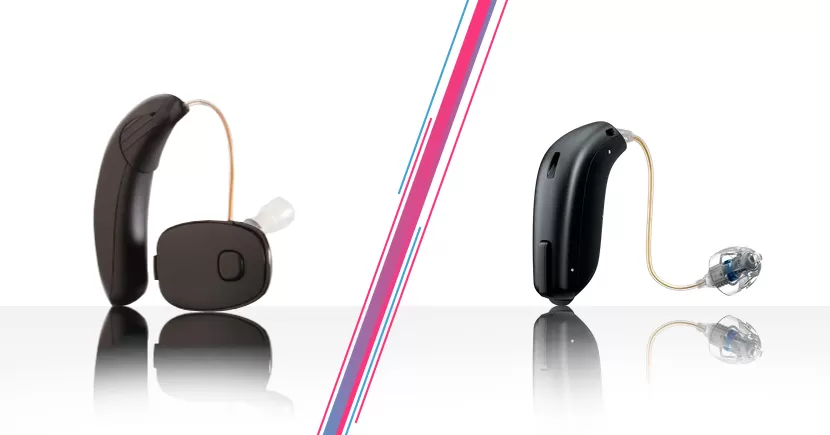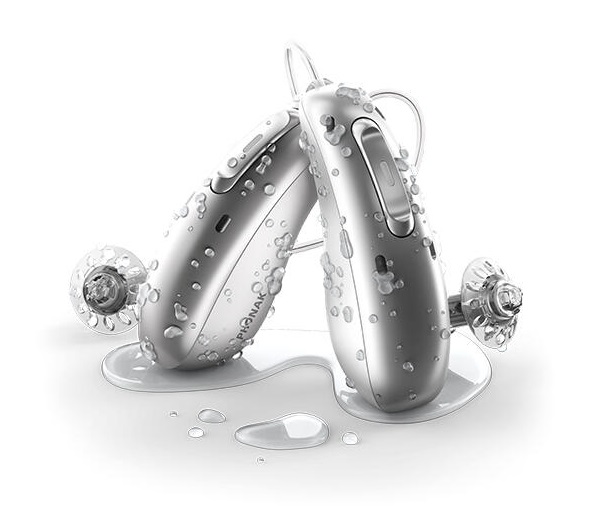1.
Microphone
The microphone picks up the sound from the environment and sends it into the hearing aid for processing. You’ll mostly want to leave the microphone alone, but periodically check it to ensure it’s not being plugged up by hair care products or oils.
2.
Pull string
This handy string makes it easier to insert and remove the hearing aid. Don’t worry- in most cases this string tucks away neatly inside the ear canal, but if it doesn’t talk to your hearing care provider about shortening or removing the pull string.
3.
Rechargeable battery
The model shown at the top of this page is powered by a rechargeable lithium-ion battery, expected to last up to 38 hours on a full charge. The battery takes about 3.5 hours to fully charge, and a 10 minute quick charge will get you about 3 hours of power. Signature Series is also available with disposable size 10 batteries which would need to be changed every 3-5 days.
4.
Push button
The CIC and CIC R models come with a push button on the faceplate of the hearing aid, which can be used to control the volume, program, or both. The IIC model does not have room for a push button. All three models can also be controlled by the T2 Remote app (shown further down on this page), and the T2 Remote all will allow you to control the volume or program.
5.
Vent
The vent runs along the entire hearing aid, usually along the bottom portion, with an opening at the faceplate of the hearing aid (outside the ear), and an opening next to the receiver/speaker of the hearing aid (inside the ear). Vents serve multiple purposes, from aiding in ventilation, to controlling sound leakage and feedback reduction. Vents can affect acoustics and sound quality, so your hearing care provider and the manufacturer will take care to ensure your hearing aid is built with the correct vent size.
6.
Wax filter
When it comes to maintaining your hearing aids, this is where you’ll spend most of your time. The wax filter (mostly) prevents wax and oils from getting into the receiver/speaker. Your hearing provider may supply you with Starkey Hear Clear wax filters enabling you to periodically change these on your own. Some people never have to change these wax filters, others have to change them weekly. Your purchase includes 1 pack of wax filters, and you can purchase additional wax filters directly from your ZipHearing provider, or through a number of sites online such as Amazon.
7.
Microphone
The microphone picks up the sound from the environment and sends it into the hearing aid for processing. You’ll mostly want to leave the microphone alone, but periodically check it to ensure it’s not being plugged up by hair care products or oils.
8.
Pull string
This handy string makes it easier to insert and remove the hearing aid. Don’t worry- in most cases this string tucks away neatly inside the ear canal, but if it doesn’t talk to your hearing care provider about shortening or removing the pull string.
9.
Rechargeable battery
The model shown at the top of this page is powered by a rechargeable lithium-ion battery, expected to last up to 38 hours on a full charge. The battery takes about 3.5 hours to fully charge, and a 10 minute quick charge will get you about 3 hours of power. Signature Series is also available with disposable size 10 batteries which would need to be changed every 3-5 days.
10.
Push button
The CIC and CIC R models come with a push button on the faceplate of the hearing aid, which can be used to control the volume, program, or both. The IIC model does not have room for a push button. All three models can also be controlled by the T2 Remote app (shown further down on this page), and the T2 Remote all will allow you to control the volume or program.
11.
Vent
The vent runs along the entire hearing aid, usually along the bottom portion, with an opening at the faceplate of the hearing aid (outside the ear), and an opening next to the receiver/speaker of the hearing aid (inside the ear). Vents serve multiple purposes, from aiding in ventilation, to controlling sound leakage and feedback reduction. Vents can affect acoustics and sound quality, so your hearing care provider and the manufacturer will take care to ensure your hearing aid is built with the correct vent size.
12.
Wax filter
When it comes to maintaining your hearing aids, this is where you’ll spend most of your time. The wax filter (mostly) prevents wax and oils from getting into the receiver/speaker. Your hearing provider may supply you with Starkey Hear Clear wax filters enabling you to periodically change these on your own. Some people never have to change these wax filters, others have to change them weekly. Your purchase includes 1 pack of wax filters, and you can purchase additional wax filters directly from your ZipHearing provider, or through a number of sites online such as Amazon.




















->getDescriptorURL()?>)

















![Buying Hearing Aids Online [Pros & Cons, Tips] Preview for the "Buying Hearing Aids Online [Pros & Cons, Tips]" video](https://cdn.ziphearing.com/dist/dynamic/files/videos/8/thumbnail/version/1/80/thumbnail.jpg)

![Rechargeable Hearing Aids [Pros & Cons] Preview for the "Rechargeable Hearing Aids [Pros & Cons] " video](https://cdn.ziphearing.com/dist/dynamic/files/videos/20/thumbnail/version/1/80/thumbnail.jpg)




















